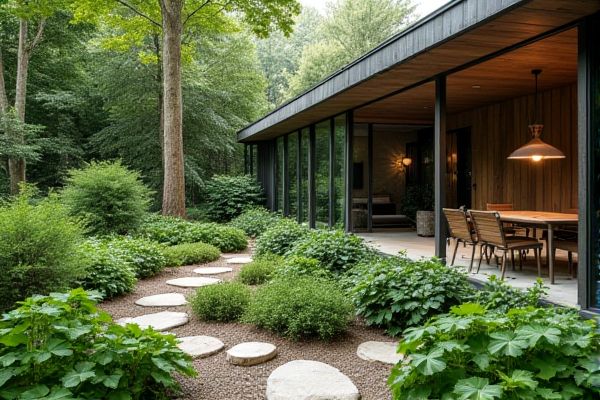
Edible gardens focus on growing fruits, vegetables, and herbs for consumption, offering fresh produce while enhancing your outdoor space, whereas ornamental gardens prioritize aesthetic appeal with decorative plants, flowers, and landscaping elements. Explore further to discover how each garden type benefits your lifestyle and environment.
Table of Comparison
| Aspect | Edible Garden | Ornamental Garden |
|---|---|---|
| Purpose | Grow fruits, vegetables, herbs for consumption | Enhance aesthetic appeal with flowers, shrubs, and decorative plants |
| Plant Types | Vegetables, fruits, herbs | Flowers, shrubs, trees, ornamental grasses |
| Maintenance | Requires regular harvesting, watering, pest control | Focus on pruning, watering, seasonal planting |
| Design Focus | Functionality and productivity | Visual appeal and landscape design |
| Soil Requirements | Rich, nutrient-dense soil for optimal growth | Varied soil types depending on plant species |
| Benefits | Fresh produce, cost savings, sustainability | Improved property value, relaxation, biodiversity |
| Typical Location | Kitchen gardens, backyard patches, raised beds | Front yards, parks, decorative borders |
| Seasonal Considerations | Planting based on growing seasons for crops | Year-round or seasonal flowering schedules |
Introduction to Edible and Ornamental Gardens
Edible gardens prioritize the cultivation of fruits, vegetables, herbs, and edible flowers, offering both aesthetic appeal and nutritive value through homegrown produce. Ornamental gardens focus primarily on decorative plants such as flowering shrubs, ornamental grasses, and sculpted foliage designed to enhance landscape beauty and create visual harmony. Each garden type serves distinct purposes, with edible gardens combining functionality and sustainability, while ornamental gardens emphasize artistic expression and biodiversity.
Key Differences Between Edible and Ornamental Gardens
Edible gardens primarily focus on cultivating fruits, vegetables, herbs, and other plants that provide food, emphasizing productivity and sustainability. Ornamental gardens prioritize aesthetic appeal through decorative plants such as flowers, shrubs, and trees chosen for their colors, shapes, and textures. The maintenance routines also differ, with edible gardens requiring regular harvesting and pest management, while ornamental gardens often focus on pruning and seasonal color enhancement.
Benefits of Growing an Edible Garden
Growing an edible garden provides fresh, nutritious produce that enhances health and reduces grocery costs. It promotes sustainability by minimizing food miles and waste while encouraging biodiversity and soil health through organic practices. Edible gardens also offer mental wellness benefits, fostering a deeper connection with nature and outdoor physical activity.
Advantages of an Ornamental Garden
An ornamental garden enhances the visual appeal of your outdoor space with vibrant flowers, diverse textures, and structured designs that create a tranquil environment. It requires less maintenance than edible gardens since plants like shrubs, perennials, and decorative grasses typically need minimal pruning and pest control. Ornamental gardens also improve property value and provide year-round aesthetic enjoyment, making them an ideal choice for those seeking beauty and low upkeep.
Design Considerations for Each Garden Type
Edible garden design prioritizes functionality, focusing on sunlight exposure, soil quality, and plant spacing to maximize crop yield and ease of harvesting. Ornamental garden design centers on aesthetics, using color schemes, plant variety, and seasonal blooms to create visual appeal and harmony with the landscape. Your choice between these garden types influences factors such as maintenance level, plant selection, and overall garden layout to suit your personal goals.
Plant Selection: Edibles vs. Ornamentals
Edible gardens prioritize selecting plants like vegetables, fruits, and herbs that provide nutrition, such as tomatoes, basil, and strawberries. Ornamental gardens focus on aesthetic appeal with plants like roses, hostas, and tulips chosen for their colors, shapes, and seasonal blooms. Your plant selection depends on whether you want to harvest food or create visual beauty in your garden space.
Maintenance Requirements: Comparison
Edible gardens demand consistent care including regular watering, pruning, fertilizing, and pest management to ensure healthy crop production, often requiring seasonal planting and harvesting schedules. Ornamental gardens generally need less frequent maintenance, focusing primarily on aesthetic pruning, weeding, mulching, and occasional fertilization to sustain visual appeal. Both garden types benefit from tailored soil management practices, but edible gardens typically require more intensive nutrient and pest control to optimize yield.
Environmental Impact of Both Gardens
Edible gardens contribute positively to the environment by supporting biodiversity, reducing carbon footprints through local food production, and improving soil health with organic practices. Ornamental gardens enhance urban ecosystems by providing habitats for pollinators and aiding in air purification, though they may require more water and chemical inputs. Your choice between edible and ornamental gardens influences local environmental sustainability, resource use, and ecological balance.
Combining Edible and Ornamental Elements
Combining edible and ornamental elements creates a garden that is both visually stunning and functionally productive, enhancing your outdoor space with vibrant flowers alongside fresh fruits, vegetables, and herbs. Strategic placement of colorful vegetables like purple kale, bright cherry tomatoes, and aromatic herbs such as basil or lavender can provide year-round beauty while maximizing harvest potential. This integration supports biodiversity, attracts pollinators, and reduces the need for separate garden areas, making your gardening experience more sustainable and enjoyable.
Choosing the Right Garden Style for Your Space
Choosing the right garden style depends largely on your available space and personal goals. An edible garden maximizes functionality by providing fresh fruits, vegetables, and herbs ideal for kitchens with limited outdoor areas. Ornamental gardens prioritize aesthetics with flowers and decorative plants to enhance your landscape's visual appeal, making them ideal for those seeking beauty and relaxation.
 homyna.com
homyna.com